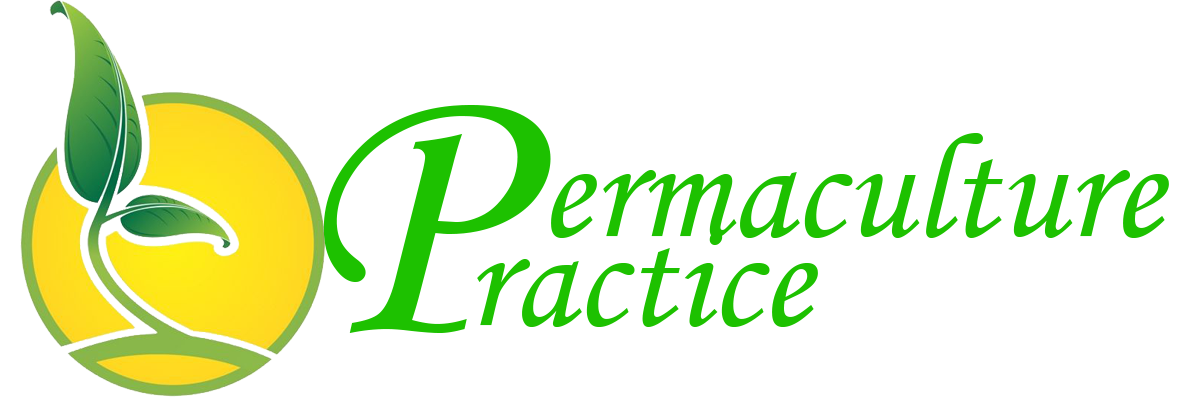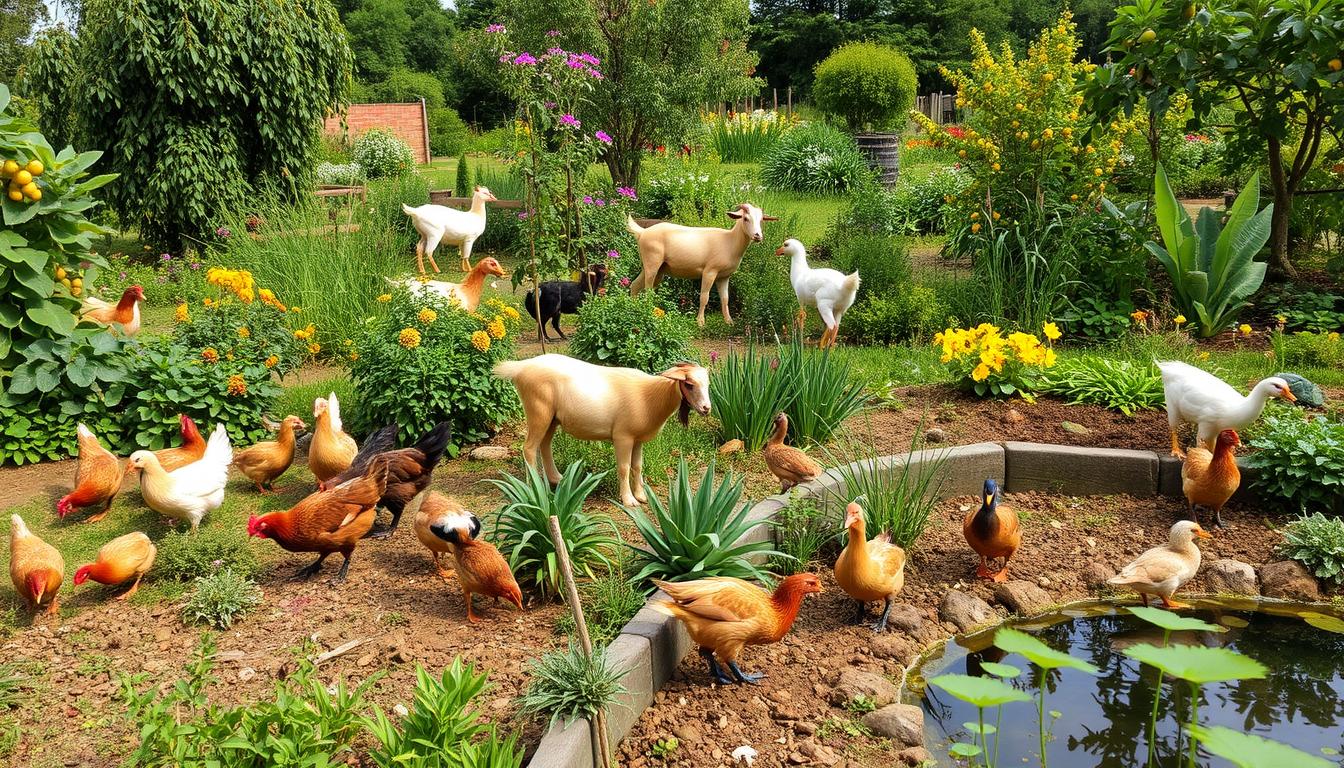I’ve always loved the way nature works together in healthy ecosystems. Adding animals to a permaculture system is more than just getting pets. It’s about creating a balance where every part helps the whole. This has shown me that animals can greatly benefit our gardens, soil, and communities.
Key Takeaways
- Adding animals to a permaculture system can help with pest control, weed management, and food production. They also help cycle nutrients through manure.
- Think about what animals need, like food, water, shelter, and space, before adding them to your design.
- It’s important to manage animal waste well. This turns it into a valuable soil amendment.
- Use rotational grazing and plant animals with certain plants to create a good relationship between them.
- Pick animals that fit your local climate and your permaculture goals.
Understanding Animal Needs in a Permaculture System
Adding animals to a permaculture system needs a deep understanding of their needs. This includes food, water, shelter, and space. It’s key for the system’s success and sustainability. Let’s look at the main points to consider when adding animals to your permaculture design.
Food Requirements
Knowing what animals need to eat is crucial. It’s not just about their health but also about preventing them from eating plants they shouldn’t. By matching their food with your permaculture plants, you create a win-win situation for both.
Water Needs
Animals need clean water every day. You must plan for their water needs and how to keep it from freezing in winter. Adding water sources like ponds helps with their hydration and supports the permaculture cycle.
Shelter Considerations
Choosing the right shelter for animals is important. Consider their space needs, sleeping habits, and whether the shelter should move or stay in one place. Knowing their natural behaviors helps you create a safe and cozy home for them.
Space and Movement
Animals need room to move and roam freely. You must ensure they have enough space and protect them from predators. This helps them thrive in your permaculture system.
Waste Management
Managing animal waste is key to a successful permaculture system. You need to handle their waste properly to keep the system healthy. This helps with soil building and nutrient cycling.
Companionship Considerations
Some animals need friends, while others prefer to be alone. You must observe their social needs. Good social dynamics improve their well-being and the system’s overall health.
By understanding and meeting these animal needs, you can build a vibrant permaculture system. It will harmoniously blend plants, animals, and the environment.
Integrating Sheep into Your Permaculture System
Choosing the right sheep breed is key when adding sheep to permaculture. Marit Parker, a Welsh sheep farmer, says hardy breeds do well in tough weather all year. But, lowland breeds need better food and shelter.
The purpose of the sheep matters too. Are they for wool, meat, or milk? This will help pick the right breed.
Choosing the Right Sheep Breed
All sheep breeds have wool, but some fleece is finer and more valuable. Some breeds grow bigger, making them better for meat. A few can even give cheese and other dairy products.
Wool, Meat, and Milk Production
Sheep need to be sheared every year for their health. But, the value of their fleece has dropped lately. This is because synthetic materials are getting more popular.
Shearing and Wool Utilization
By picking the right sheep breeds and managing their wool, meat, and milk, they can be very useful in permaculture. They provide many resources and help make the farm more sustainable.
“The combination of Holistic Management and Permaculture has shown success in dryland regions for boosting soil fertility and crop productivity.”
Incorporating Cows into Your Permaculture Design
Cows need more space than sheep but fit well in permaculture. They can be for beef or dairy, or even both. These pasture-raised cattle help keep the meadow biodiversity high and the soil rich in carbon sequestration.
Cows and sheep have different eating habits. Cows like longer grass, while sheep prefer shorter. By moving them around, the pasture stays healthy and diverse.
| Breed | Primary Purpose | Secondary Purpose |
|---|---|---|
| Dual-Purpose Breeds | Milk Production | Meat Production |
| Beef Breeds | Meat Production | Leather |
| Dairy Breeds | Milk Production | Calves for Veal or Beef |
Adding cows in permaculture means knowing their needs. This includes food, water, and shelter. With the right care, cows help the whole system thrive.
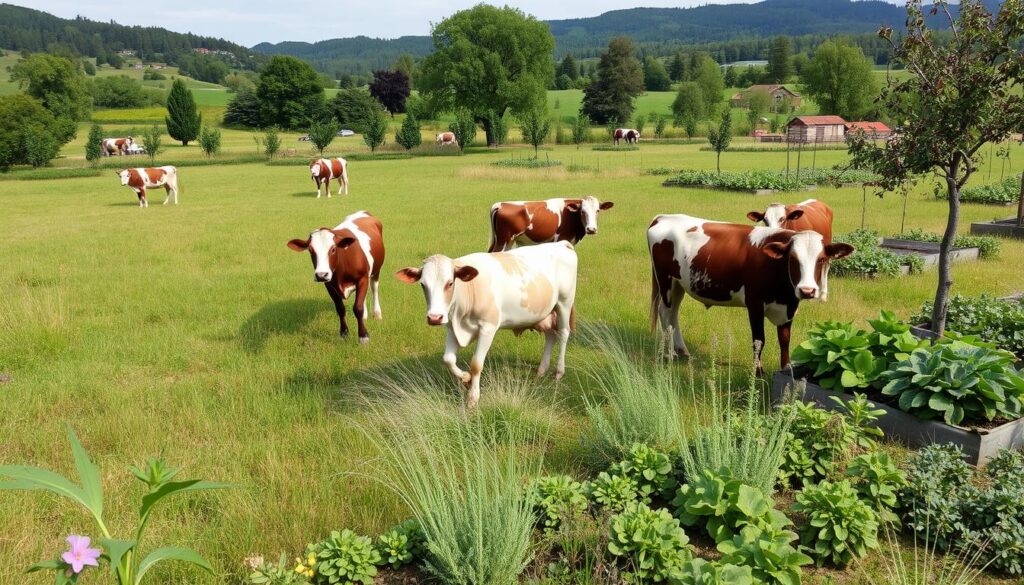
“Cows are essential in maintaining the ecological balance of a permaculture system, as their grazing habits and manure production play a vital role in soil health and nutrient cycling.”
The Role of Goats in Permaculture
In permaculture, goats are key to a healthy ecosystem. They eat unwanted plants like trees and weeds. This makes them very useful in permaculture.
Browsing Habits and Fencing
Goats eat a wide variety of plants, including leaves and stems. They can clear areas that other animals can’t. But, they need strong fencing because they can jump and climb.
Good fencing keeps them in their place. It helps protect the permaculture system from damage.
Milk, Cheese, and Meat Production
Goats give milk, cheese, and meat. They produce 1-2 liters of milk daily. Some families buy extra milk when it’s not enough.
Goats often have twins. They are kept for meat, hides, and manure. A group of 15 people share milking duties and trade milk.
| Product | Average Yield |
|---|---|
| Milk | 1-2 liters per day |
| Meat | Varies by breed and farming practices |
| Fiber (Cashmere and Mohair) | Prized fibers utilized in high-end fashion and textiles |
Goats help the environment by improving biodiversity and soil health. Their manure adds nutrients to the soil. They also help fight climate change by promoting plant growth.
Adding goats to permaculture needs careful planning. You must provide the right food, check their health, and keep them safe. With good management, goats bring many benefits to permaculture.
Alpacas and Llamas in Permaculture
Alpacas and llamas are great for permaculture. They are smart and gentle. They need less food, give fiber, and guard other animals. The article “Permaculture Alpacas” by Claire Gregory shows how to use alpacas in permaculture.
These animals do well on many types of plants. They eat grasses, shrubs, and trees. This makes them perfect for growing many plants together.
| Metric | Value |
|---|---|
| Stock rates for alpacas | Vary from one alpaca per couple of hundred square yards to two acres per alpaca, depending on the season. |
| Alpaca fiber and berries | Alpaca fiber is sold as handspun yarn, while the berries are sold for around $5 per gallon. |
| Veterinary care | Limited, with only one vet in the area willing to work with alpacas, potentially causing issues with timely medical attention. |
Alpacas and llamas also protect other animals. They keep predators away. Their calm and social nature helps them live well with other animals.
When adding alpacas and llamas to permaculture, think about their needs. They need shelter, water, and space. Meeting these needs helps these animals thrive and makes the system better.
Rabbits: Manure, Meat, and Weed Control
Permaculture systems often use rabbits for their many benefits. They are easy to care for and don’t need a lot of space. But, they need to be caged to avoid predators.
Rabbit manure is a key reason to keep them in permaculture. It can be composted and adds nutrients to the soil. Integrated crop-livestock systems can enhance soil aggregate-associated carbon and nitrogen, with a rating of 8.0.
Rabbits are also a good source of meat. They breed quickly, making them a practical choice for protein. A study in southwestern France measured trade-offs related to crop-livestock integration and gave a score of 9.0.
Rabbits can also control weeds in permaculture. Their grazing helps trim grasses and small plants. Rabbits can help trim grasses and small plants in the food forest.
| Benefit | Description | Rating |
|---|---|---|
| Manure | Rabbit manure can be composted and used to enrich the soil, providing valuable organic matter and nutrients for plant growth. | 8.0 |
| Meat Production | Rabbits are a reliable source of protein due to their quick reproduction rate, making them a practical meat option for permaculture. | 9.0 |
| Weed Control | Rabbits can help trim grasses and small plants, making them a natural weed control tool in the permaculture design. | 7.5 |
Adding rabbits to a permaculture system offers many benefits. They provide manure, meat, and weed control. This makes farming more self-sufficient and sustainable.
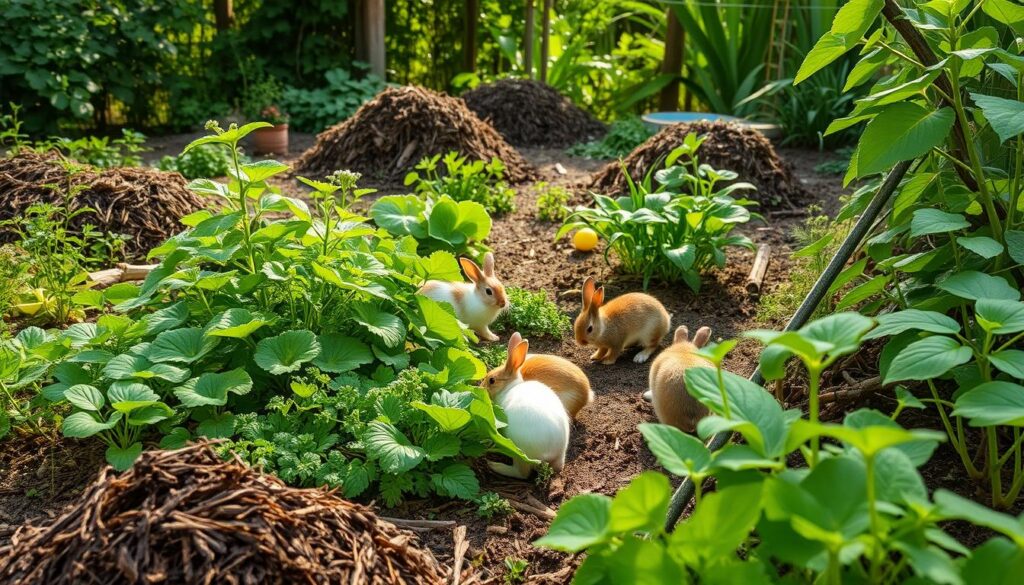
Integrating Poultry into Your Permaculture System
Poultry like chickens, ducks, geese, and guinea fowl are great for permaculture. They bring many benefits that make your property more productive and sustainable. Let’s see how to add these birds to your permaculture design.
Chickens for Pest Control and Egg Production
Chickens are great at controlling pests like insects, slugs, and small rodents. By adding chickens to your permaculture, you can keep pests away from your crops. They also give you fresh eggs, which are good for eating or selling.
Ducks and Geese for Weed Management
Ducks and geese are good at keeping weeds down. They like grasses and clovers, which helps control unwanted plants. Adding ducks and geese to your design can cut down on weeding and keep your ecosystem balanced.
Guinea Fowl for Insect Control
Guinea fowl eat lots of insects, including ticks and snakes. They help control pests naturally. They also scare away bigger predators, protecting your other animals.
It’s important to take good care of your poultry. Make sure they have a good coop, manage their breeding, and watch for health problems. This way, poultry will fit well into your permaculture, helping your garden and making it more sustainable.
“Poultry are the perfect permaculture companions, offering a diverse range of benefits that enhance the productivity and resilience of the entire system.”
permaculture animal integration
Adding livestock to a permaculture system offers many advantages. It helps with site preparation, tillage, and controlling weeds and insects. By integrating animals wisely, you can build a self-sustaining ecosystem that works with nature. Let’s look at how to include animals in your permaculture design.
Goats are great at clearing brush and shrubs. Pigs can till the soil and find deep-rooted weeds. Sheep, chickens, ducks, and geese manage the understory, keeping grasses and weeds in check without harming crops. Poultry like chickens, ducks, and guinea fowl also control pests and insects. They help break disease and pest cycles by eating dropped fruits and nuts.
When adding animals, it’s key to think about their food, water, shelter, space, and needs. You must manage them well to avoid harming young trees and the herbaceous understory. Knowing each animal’s unique traits and behaviors helps create a balanced and thriving permaculture system.
- Begin with a small number of animals in your permaculture system. Watch their day and year cycles, understand their nutrient needs, and see how they affect your farm design and operation.
- Make sure animals have clean water, especially ducks in hot weather, to keep conditions sanitary.
- Be flexible as animals grow and change, adjusting your approach as needed.
- Always prioritize animal welfare and follow routine care to keep your livestock healthy and happy.
By carefully integrating animals into your permaculture design, you can get the most benefits while keeping your ecosystem balanced and sustainable. With good planning and observation, you can build a thriving permaculture system that harmonizes with nature.
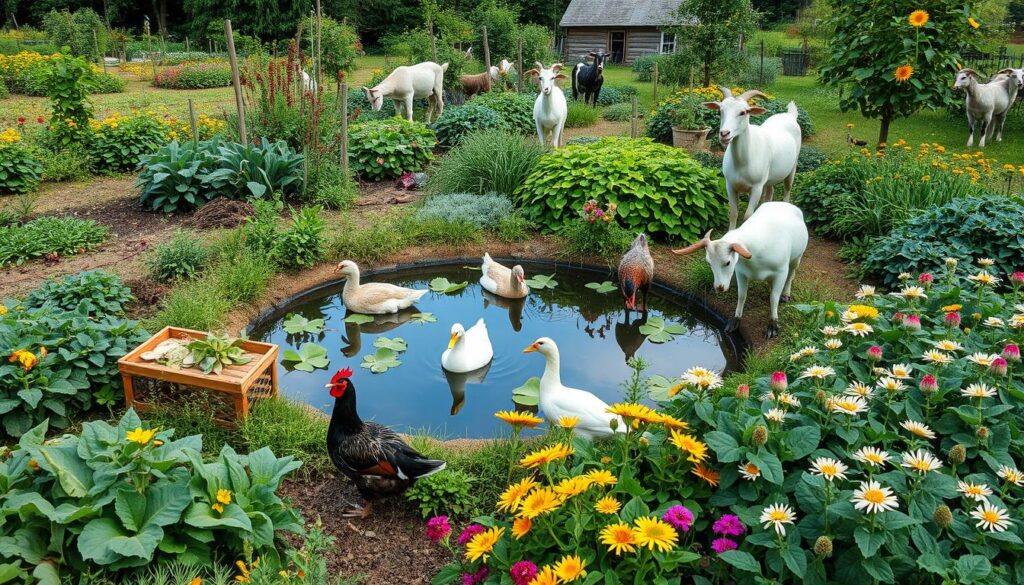
Pets and Wildlife in Permaculture
Pets are a big part of many families. They shouldn’t be left out when planning a permaculture system. Composting pet waste turns it into a nutrient-rich soil amendment for your land. Also, creating wildlife habitats in your design supports a variety of species, from small animals to birds and bees.
Composting Pet Waste
Pet waste can be a valuable resource in permaculture when composted right. By following the best practices for composting pet waste, you can make a nutrient-rich soil amendment. This not only reduces the environmental impact of pet waste but also helps close the loop in your permaculture ecosystem.
Creating Wildlife Habitats
Understanding the needs of wildlife in your area helps you include their habitats in your design. You can provide food, nesting sites, and movement corridors. Your permaculture system can become a haven for many species. Supporting wildlife promotes a healthier, more balanced ecosystem.
Pets and wildlife are key to a thriving permaculture system. By composting pet waste and creating habitats, you help your ecosystem’s health and resilience. Integrating these elements makes your environment more diverse and sustainable, benefiting your family and the natural world.
Conclusion
Adding animals to a permaculture system brings many benefits. These include pest control, weed management, nutrient cycling, and food production. By understanding the needs of different animals, you can create a system that makes your land healthier and more resilient.
Starting with small animals like chickens and rabbits or larger ones like cows and sheep is key. The goal is to use a holistic approach that fits with permaculture’s principles. This includes animal integration, sustainable livestock systems, and holistic land management.
This approach helps create a thriving, sustainable ecosystem. Livestock help by providing manure for compost, controlling pests, and managing land through grazing. Small-scale farming fits better with permaculture, allowing for better management and a smaller ecological footprint.
Adding livestock to a permaculture farm makes it more resilient. It helps against crop failures and market changes, making mixed farming a safe and sustainable choice. It’s also important to consider the welfare of animals in permaculture farming. This ensures their well-being and supports sustainable, humane farming practices.
